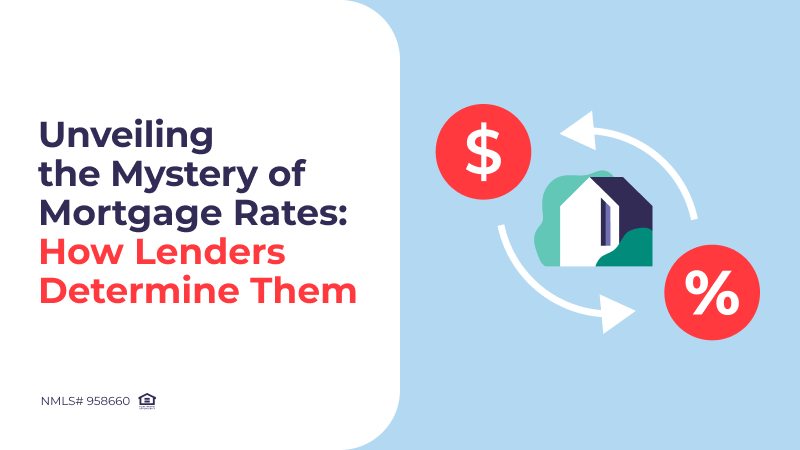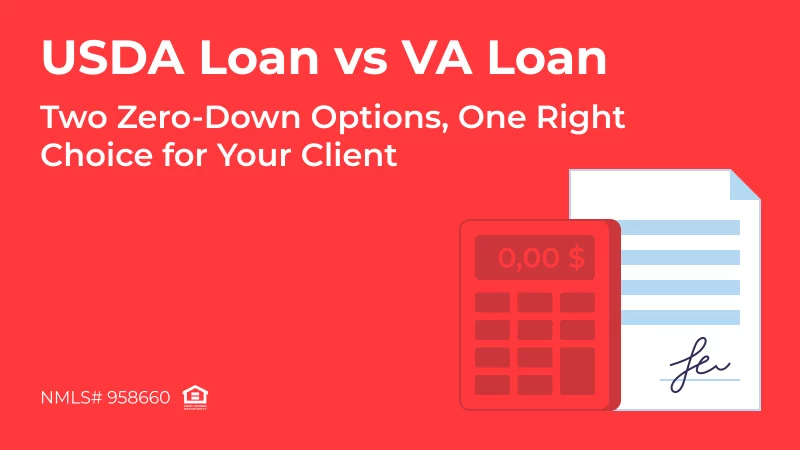If you’re new to buying a home or working in mortgage brokerage, it’s crucial to know as much as possible about the mortgage rates. These rates affect your monthly payments for years a home affordability. Understanding the factors behind these rates can help you make smarter decisions and get better loan terms. So, how are mortgage rates determined? This guide will help you understand how lenders determine mortgage rates, giving brokers and homebuyers insights to secure favorable loan terms.
The Basics of Mortgage Rates
Looking for a suitable loan program?
Choose among 20+ programs and get
a detailed loan calculation
Loan Calculator
Programs
Mortgage rates are the interest rates assigned to a loan used for buying a property. These rates are crucial in the home-buying process as they determine how much a borrower needs to repay the lender over the loan’s life. Specifically, the mortgage interest rate affects the monthly payment, the total home financing cost, and ultimately, the homes within a borrower’s reach.
At its core, a mortgage rate is all about interest, the cost of borrowing money. Interest allows lenders to earn on the money loaned, compensating for lending risks and the opportunity cost of investing in mortgages over other options. The mortgage rate is stated as an annual percentage of the loan amount.
For instance, a 4% mortgage rate on a $300,000 loan translates to an annual interest cost of $12,000, or $1,000 monthly, alongside the principal repayment.
The interest rate heavily impacts the total mortgage expense. A lower rate means lower monthly payments and less overall payment. Conversely, a higher rate not only raises monthly expenses but also increases the total paid by the mortgage’s end. Thus, even slight rate differences can lead to significant cost changes.
For example, a 0.5% rate variation on a $300,000 loan can mean thousands over a 30-year mortgage.
Mortgage Rate Scenario Examples
Scenario 1: Impact of a Rate Increase
Consider a borrower, Sarah, who is looking to purchase a $300,000 home with a 30-year fixed-rate mortgage. If she locks in a rate of 4%, her monthly mortgage payment (principal and interest) would be approximately $1,432. However, if the rate increases to 4.5% before she locks in her rate, her monthly payment rises to about $1,520. Over the life of the loan, this half-percent increase will cost Sarah an additional $31,680.
Scenario 2: Benefits of a Lower Rate via a Larger Down Payment
John is aiming to buy a home priced at $250,000. He initially considered making a 10% down payment, which would require him to pay private mortgage insurance (PMI) and potentially secure a higher interest rate due to a higher loan-to-value ratio. After consulting his mortgage broker, John decides to save up for a 20% down payment, reducing his need for PMI and lowering his interest rate from 3.75% to 3.5%. This decision reduces his monthly payments and results in significant savings over the life of the loan.
How Are Mortgage Rates Determined? Economic Factors
Mortgage rates aren’t set in a vacuum; they’re heavily influenced by broader economic conditions. Factors like economic growth, inflation, and unemployment rates all play big roles in deciding these rates.
Economic Growth
Economic growth directly impacts mortgage rates. When things are going well economically, people and businesses tend to spend and invest more, which means they need more loans, including mortgages. Lenders might raise interest rates because of the increased demand for borrowing. On the flip side, during economic slowdowns, mortgage rates could drop as lenders lower rates to encourage more borrowing and boost the economy.
Inflation
Inflation, or how prices for goods and services increase over time, is another important factor in how mortgage rates are determined. Lenders worry about the future value of the money they’re getting paid back. If inflation is high, the money they get back might not buy as much as it used to. To make up for this, lenders might raise mortgage rates to protect their profits. So, when inflation is on the rise, mortgage rates usually follow suit.
Unemployment Rates
Unemployment rates can indirectly affect mortgage rates too. High unemployment tends to make people spend less and slows down economic growth, which could lead to lower interest rates to encourage more spending and boost the economy. On the flip side, low unemployment usually signals a strong economy, potentially causing higher mortgage rates because more people are looking to borrow money.
The Role of the Federal Reserve
The Federal Reserve, as the central bank of the United States, plays a crucial role in shaping economic policy. This includes influencing interest rates through monetary policy decisions. By adjusting the federal funds rate, which is the rate at which banks lend reserve balances to each other overnight, the Fed impacts short-term interest rates. These changes trickle down to affect consumer and business loans, such as mortgages. Moreover, the Federal Reserve can influence longer-term rates by buying or selling Treasury bonds and other securities through open market operations.
Mortgage-Backed Securities and the Bond Market
In the bond market, specifically through mortgage-backed securities (MBS), there is a direct link to mortgage rates. MBS are investment products backed by home loans purchased from banks. When investors are confident, they are less inclined to invest in these safer bonds, which drives prices down and yields up. Since mortgage rates often follow these yields, a drop in MBS prices can lead to higher mortgage rates. Conversely, if investors prioritize safety, MBS prices may rise, resulting in lower mortgage rates.
How Are Mortgage Rates Determined? Personal Factors
Troubles with a scenario for a borrower?
Message our loan expert and get
a response in 30 minutes.
Submit a Scenario
When it comes to mortgage rates, economic indicators help set the general level, but your personal financial info plays a big role in the rate you actually get. Things like credit scores, loan-to-value ratio, debt-to-income ratio, and your down payment size matter.
Credit Scores
Your credit score is a big deal when it comes to your mortgage rate. It shows how good you are at managing credit and paying debts on time. Higher scores mean lower risk for lenders, so they usually offer lower rates to those with good credit. On the flip side, lower scores may lead to higher rates because lenders see more risk.
Loan-to-Value Ratio (LTV)
The LTV ratio, which compares your loan amount to the property’s value, is another key factor for rates. A lower LTV means you have more equity in the property, making it less risky for the lender. Borrowers with lower LTV ratios often get better rates because lenders feel more secure.
Debt-to-Income Ratio (DTI)
Your DTI ratio, which looks at your monthly debt compared to your income, also affects rates. A lower DTI shows you can manage your payments well, reducing the risk of default. Borrowers with lower DTI ratios usually get offered lower rates as a result.
Impact of Down Payment Size
The size of your down payment also plays a big role in how mortgage rates are determined. A bigger down payment lowers the risk for the lender by reducing the LTV ratio, as we talked about earlier. It also shows that you’re financially responsible and have good savings habits, which lenders like to see. So, if you put down a larger sum, you could end up with lower mortgage rates. This could lead to saving a lot of money over your mortgage term, making it a smart move for potential homeowners.
In essence, your personal finances really affect the mortgage rates you’re offered by lenders. By working on things like boosting your credit score, saving up for a bigger down payment, and keeping your debt in check compared to your income, you can set yourself up for better mortgage deals.
Types of Loans and Their Rates
When it comes to mortgages, there’s a wide range of products out there, each with its own rates and terms that play a big role in how much you end up paying and how your loan is structured. The main categories include fixed-rate mortgages, adjustable-rate mortgages, government-backed loans, and conventional loans.
Fixed-Rate Mortgages vs. Adjustable-Rate Mortgages (ARMs)
With fixed-rate mortgages, you get the stability of a constant interest rate and monthly payments that stay the same throughout the loan term. This predictability makes it easier to budget since you know exactly what you’ll owe each month, no matter how the market shifts. On the flip side, fixed-rate mortgages may come with higher initial rates compared to adjustable-rate mortgages.
Adjustable-rate mortgages (ARMs) usually start off with lower interest rates than fixed-rate options, which can be appealing if you want lower initial payments. However, the interest rates on ARMs can fluctuate after an initial period, based on a specific index plus a margin, reflecting changes in market rates. While ARMs might save you money in the long run, they also bring in some uncertainty and the possibility of higher future payments.
Government-Backed Loans vs. Conventional Loans vs Non-QM Loans
Government-backed loans like those from the Federal Housing Administration (FHA), Department of Veterans Affairs (VA), and United States Department of Agriculture (USDA) aim to make homeownership more accessible by offering lower rates and smaller down payments. VA and USDA loans may even require no down payment at all due to the government’s guarantee, reducing the lender’s risk.
Conventional loans, on the other hand, don’t have government backing, which means higher risk for lenders. They typically need larger down payments and stricter credit scores, leading to potentially higher interest rates, especially for those with less-than-perfect credit.
Non-QM (Non-Qualified Mortgage) Loans are an option for borrowers who don’t fit the conventional or government-backed loan criteria. They cater to individuals with unique financial situations like self-employed individuals or those with higher debt-to-income ratios. These loans might have higher interest rates as they don’t meet the standard definitions set by the Consumer Financial Protection Bureau (CFPB) for Qualified Mortgages. Despite this, Non-QM loans offer flexibility for those who struggle to secure traditional mortgage financing.
Knowing the variations in rates and terms among these mortgage options is crucial for borrowers to choose what aligns best with their financial circumstances and home-buying aspirations.
How Brokers and Borrowers Can Influence Rates
Getting a better mortgage rate isn’t just about looking for the best deal but also about getting your finances to impress lenders. Brokers and borrowers alike can do certain things to positively impact the rates that lenders offer. Here are some practical tips for boosting credit scores, saving up for larger down payments, and selecting the right loan type to secure more attractive mortgage rates.
Improving Credit Scores
Having a higher credit score is key to securing lower mortgage rates. Brokers should recommend that clients start by checking their credit reports for any errors that might be dragging down their scores. Keeping track regularly can also help identify and fix these issues early on. It’s helpful to pay off existing debts, especially high-interest credit cards, as it not only improves the credit utilization ratio but also shows responsible credit management. Building a track record of making timely payments on all accounts, which plays a significant role in the credit score, is crucial.
Increasing Down Payments
The size of the down payment directly impacts the loan-to-value ratio, a crucial element in how mortgage rates are determined. Brokers should advise borrowers to save aggressively to boost their down payment amount. This not only lowers the LTV ratio but also increases equity in the property more quickly. A down payment of 20% or more typically helps avoid the extra cost of private mortgage insurance (PMI), which can raise monthly expenses and the overall loan cost.
Choosing the Right Loan Type
When it comes to choosing the right mortgage, the type you select can make a big difference in how much interest you pay over the life of the loan. As a broker, it’s important to help your clients weigh the pros and cons of fixed-rate and adjustable-rate mortgages. If someone is looking to settle in for the long haul, a fixed-rate mortgage provides stability. On the other hand, an adjustable-rate mortgage could be a good fit for those planning a shorter stay or anticipating an increase in income down the road.
It’s also valuable to talk about government-backed loan possibilities with eligible clients since these can come with more favorable terms like lower interest rates and down payment requirements. Understanding the ins and outs of conventional, FHA, VA, and Non-QM loans empowers borrowers to make well-informed choices that match their financial situation and homeownership objectives.
By focusing on these aspects, brokers and borrowers can wield significant influence over the mortgage rates they secure.
How Are Mortgage Rates Determined in the Future?
The mortgage industry keeps changing, influenced by tech advancements, policy shifts, and economic trends. Looking ahead, certain things could really shake up mortgage rates.
Technological Advancements
Technology is going to be huge in shaping future mortgage rates. Using digital processes and AI in loan processes could speed up mortgage applications, making rates more competitive. Automation might cut costs and errors, helping lenders offer better rates.
Policy Changes
Changes in laws and regulations could also sway mortgage rates. Housing policy tweaks or shifts at Fannie Mae and Freddie Mac could change how mortgages are done. Plus, the Fed’s money policy changes in response to the economy will affect interest rates, which in turn impacts mortgage rates.
Economic Trends
Overall economic trends, like inflation and employment, will impact mortgage rates. A strong post-pandemic recovery could mean higher rates due to more home demand. At the same time, an economic slump might lead to lower rates to boost the housing market.
Conclusion
Knowing how mortgage rates are determined, from individual finances to worldwide economic factors, is vital. By keeping up with economic shifts and understanding rate determinants, brokers offer crucial support to clients handling home financing challenges. This hands-on method not only helps clients but also solidifies the broker’s position as a trusted advisor in mortgages.
FAQ
How exactly do credit scores affect mortgage rates?
Credit scores directly influence the interest rate offered on a mortgage. Higher scores generally qualify for lower rates because they indicate a lower risk of default to the lender. Typically, borrowers with scores in the highest range (740 and above) receive the most favorable rates.
Can you explain the relationship between the Federal Reserve’s policies and mortgage rates?
The Federal Reserve influences mortgage rates primarily through its policy actions on the federal funds rate and open market operations. That includes the purchasing of mortgage-backed securities. When the Fed lowers the federal funds rate, it usually leads to lower mortgage rates. Conversely, raising the rate can drive mortgage rates higher.
What’s the difference between fixed-rate and adjustable-rate mortgages in terms of long-term cost?
Fixed-rate mortgages provide stability because the interest rate remains the same throughout the term, which makes financial planning easier. Adjustable-rate mortgages (ARMs) may start with a lower rate than fixed-rate mortgages. However, the rate can change based on market conditions, potentially leading to higher costs in the long term.
Are government-backed loans always a better option due to their lower rates?
Government-backed loans, like FHA and VA loans, often offer attractive terms, including lower interest rates and down payment requirements. Naturally, it can make them a better option for eligible borrowers. However, they also come with specific criteria and costs, such as mortgage insurance premiums, that might not suit everyone. It’s important for borrowers to discuss these options with their brokers to determine the best fit based on individual circumstances.




